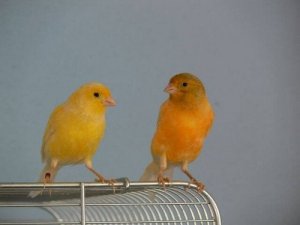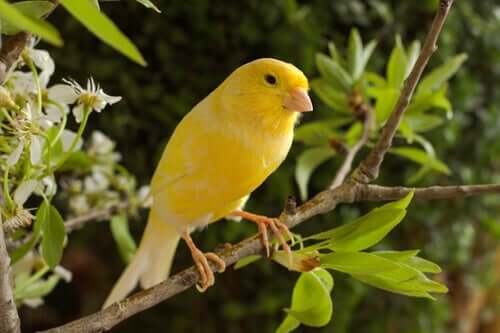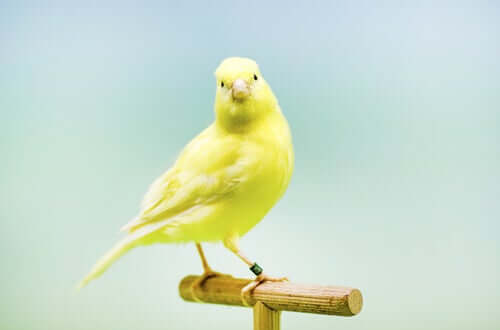Learn about Canary Mating Behavior!


Written and verified by the lawyer Francisco María García
Although you may not believe it, there are some guidelines when it comes to mating canaries in captivity. These are properly oriented to respect the birds’ organism and not put their health at risk. In order to do this, it’s mandatory to possess a better knowledge of the species and its reproductive cycle. Interested in learning more about canary mating behavior? Read on and we’ll tell you!
Terminology and origins
The term canary popularly names the different breeds of the species “Serinus canaria”. Their bodies are long and small, and they have brightly colored feathers, small round eyes, and a tiny cone-shaped beak. In addition, their diet is basically a granivorous one and they love to sing softly.
Among the many practices of breeding and mating domestic birds, canary culturing is probably the most popular. This practice has spread to countries in Europe and America. However, this is thanks to the birds’ easy handling, it’s economic efficiency and their need for little space.

Canary breeding and mating can be carried out in small environments. However, the birds need to be prepared first. If your canaries are already in the reproductive stage, the following tips will prove to be very useful.
Canary mating behavior and reproductive cycle
The first step in canary mating is to select the most suitable male and female specimens. This is why it’s so important to know their reproductive cycle better first.
Most birds’ reproductive cycles are usually seasonal. This means that they mate during a certain time of the year and according to their habitat’s conditions.
In the wild, canaries normally mate when the days are longer and there’s more daylight. That’s to say, from the arrival of spring until the end of summer.
Therefore, we recommend choosing the best-prepared males and females for mating by the end of Winter. The ideal way is to observe their behavior, weight, age, and health while choosing the best couples better.
What’s the best moment for canary mating?
Females reach their sexual maturity at 7 months of age, while males reach sexual maturity at 9 months. At this age, they’re already fertile, but it’s recommended to wait until they’re a year old to ensure better breeding.
The canaries must be well fed and in good health in order to reproduce effectively. Their character should be cheerful and with a good disposition when Spring arrives. Ideally, they should molt their feathers 3 months before the reproductive cycle begins. Otherwise, mating may endanger the lives of the male, the female, and future chicks.
Nowadays, many breeders choose to artificially stimulate the canaries’ heating period in order to promote their breeding season.
Matching the couples together
It’s actually quite simple to recognize when a canary’s on heat. Likewise, it’s fairly easy to distinguish males from females at this point in the season.
First things first: you must properly get hold of one bird at a time. Next, as you blow some air into their feathers, observe the different formations of the anal area. As a result, you’ll notice that males in heat have a protuberance in this region. On the other hand, females will have a bulging and flattened anal area.
As soon as you notice the arrival of the heat period in your chosen couples, you can get them together during the first morning hours. Canary mating usually happens during the day, when there’s abundant sunlight.
Normally, males and females start mating during the first 3 days. When that doesn’t happen, breeders use a small “trick”. This trick consists of turning a light on during night time, increasing their mating time. The intention is to gently illuminate the environment, simulating a sunrise.

Nest details and egg-laying
If the mating was successful, the female should soon start building the nest for egg-laying.
At this point, you should choose a good artificial nest for the chicks. Nests of different materials, sizes and prices are sold in pet shops. The choice should be influenced by the cage’s size and available space.
It’s also essential to offer them some nest materials, such as sterilized hair. The female herself will accommodate it to build a cradle for her eggs.
Females usually lay one egg per day until they reach between 4 to 6 months of brooding. In general, a canary will lay between 4 and 6 eggs per mating.
When the egg-laying is done, it’s advisable to carry out an assisted egg incubation.
The eggs
Every egg should be carefully removed from the nest at the end of the afternoon and replaced by a small stone. The egg is then to be placed in a small box lined with some clean cotton. When the female has finished laying, then the eggs are returned to the nest.
This procedure allows the chicks to hatch at the same time. In addition, this should also prevent them to suffer from the mother’s priority feeding on the other chicks and be underfed.
We hope you enjoyed this interesting article about canary mating behavior and happy breeding!
Although you may not believe it, there are some guidelines when it comes to mating canaries in captivity. These are properly oriented to respect the birds’ organism and not put their health at risk. In order to do this, it’s mandatory to possess a better knowledge of the species and its reproductive cycle. Interested in learning more about canary mating behavior? Read on and we’ll tell you!
Terminology and origins
The term canary popularly names the different breeds of the species “Serinus canaria”. Their bodies are long and small, and they have brightly colored feathers, small round eyes, and a tiny cone-shaped beak. In addition, their diet is basically a granivorous one and they love to sing softly.
Among the many practices of breeding and mating domestic birds, canary culturing is probably the most popular. This practice has spread to countries in Europe and America. However, this is thanks to the birds’ easy handling, it’s economic efficiency and their need for little space.

Canary breeding and mating can be carried out in small environments. However, the birds need to be prepared first. If your canaries are already in the reproductive stage, the following tips will prove to be very useful.
Canary mating behavior and reproductive cycle
The first step in canary mating is to select the most suitable male and female specimens. This is why it’s so important to know their reproductive cycle better first.
Most birds’ reproductive cycles are usually seasonal. This means that they mate during a certain time of the year and according to their habitat’s conditions.
In the wild, canaries normally mate when the days are longer and there’s more daylight. That’s to say, from the arrival of spring until the end of summer.
Therefore, we recommend choosing the best-prepared males and females for mating by the end of Winter. The ideal way is to observe their behavior, weight, age, and health while choosing the best couples better.
What’s the best moment for canary mating?
Females reach their sexual maturity at 7 months of age, while males reach sexual maturity at 9 months. At this age, they’re already fertile, but it’s recommended to wait until they’re a year old to ensure better breeding.
The canaries must be well fed and in good health in order to reproduce effectively. Their character should be cheerful and with a good disposition when Spring arrives. Ideally, they should molt their feathers 3 months before the reproductive cycle begins. Otherwise, mating may endanger the lives of the male, the female, and future chicks.
Nowadays, many breeders choose to artificially stimulate the canaries’ heating period in order to promote their breeding season.
Matching the couples together
It’s actually quite simple to recognize when a canary’s on heat. Likewise, it’s fairly easy to distinguish males from females at this point in the season.
First things first: you must properly get hold of one bird at a time. Next, as you blow some air into their feathers, observe the different formations of the anal area. As a result, you’ll notice that males in heat have a protuberance in this region. On the other hand, females will have a bulging and flattened anal area.
As soon as you notice the arrival of the heat period in your chosen couples, you can get them together during the first morning hours. Canary mating usually happens during the day, when there’s abundant sunlight.
Normally, males and females start mating during the first 3 days. When that doesn’t happen, breeders use a small “trick”. This trick consists of turning a light on during night time, increasing their mating time. The intention is to gently illuminate the environment, simulating a sunrise.

Nest details and egg-laying
If the mating was successful, the female should soon start building the nest for egg-laying.
At this point, you should choose a good artificial nest for the chicks. Nests of different materials, sizes and prices are sold in pet shops. The choice should be influenced by the cage’s size and available space.
It’s also essential to offer them some nest materials, such as sterilized hair. The female herself will accommodate it to build a cradle for her eggs.
Females usually lay one egg per day until they reach between 4 to 6 months of brooding. In general, a canary will lay between 4 and 6 eggs per mating.
When the egg-laying is done, it’s advisable to carry out an assisted egg incubation.
The eggs
Every egg should be carefully removed from the nest at the end of the afternoon and replaced by a small stone. The egg is then to be placed in a small box lined with some clean cotton. When the female has finished laying, then the eggs are returned to the nest.
This procedure allows the chicks to hatch at the same time. In addition, this should also prevent them to suffer from the mother’s priority feeding on the other chicks and be underfed.
We hope you enjoyed this interesting article about canary mating behavior and happy breeding!
This text is provided for informational purposes only and does not replace consultation with a professional. If in doubt, consult your specialist.








